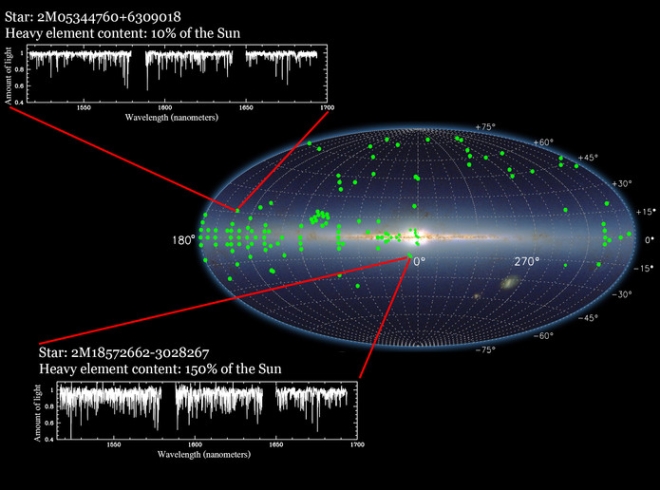August 2, 2013
Barbara K. Kennedy
UNIVERSITY PARK, Pa. -- Scientists with the Sloan Digital Sky Survey III(SDSS-III), including Penn State astronomers, have released to the public a new online data set featuring 60,000 stars that are helping to reveal how our Milky Way galaxy formed.
"This data set is unprecedented for investigating the history and structure of our galaxy, as well as nearby low-mass stars," said Penn State assistant professor of astronomy and astrophysics Suvrath Mahadevan, one of the SDSS-III scientists.
The highlight is a new set of high-resolution measurements of the amount of infrared light given off by each star at each wavelength. The scientists used infrared light, which is invisible to human eyes, because this light is able to penetrate the veil of dust that obscures the center of the galaxy. This light-blocking barrier limited the ability of previous studies to consistently reveal information about the stars in the Milky Way that were hidden behind the dust.
The new infrared detections are made possible by a new SDSS-III instrument that is part of an effort to create a comprehensive census of our Milky Way galaxy -- the SDSS-III's Apache Point Observatory Galactic Evolution Experiment (APOGEE). The new spectra are the first data to be released by the APOGEE project. "The APOGEE instrument was designed for observing the infrared light from these hidden stars in our Galaxy," Mahadevan said. "This innovative instrument can obtain spectra of 300 stars in a single observation. Our goal is to obtain detailed information on approximately 100,000 stars during the three-year span of the APOGEE survey."
The question of how our Milky Way galaxy formed has been the subject of scientific speculation and debate for centuries. APOGEE's three-dimensional map will provide key information for resolving central questions about how our galaxy formed over the many billions of years of its history. The key is learning the compositions and motions of stars in each region of the galaxy. Mahadevan has led efforts to characterize low-mass stars and binary stars found during the APOGEE experiment.
The SDSS-III team also is publishing another 685,000 spectra from galaxies and quasars whose light began traveling toward Earth when our universe was much younger, just as the mysterious force of "dark energy" was beginning to influence the universe's expansion. These observations come from the SDSS-III Baryon Oscillation Spectroscopic Survey (BOSS). "The BOSS project is producing superb data that allow numerous investigations ranging from the large scale evolutionary history of the universe to the properties of supermassive black holes, which have the size of the solar system," said distinguished professor of astronomy and astrophysics Niel Brandt, another Penn State scientist involved with SDSS-III.
Donald Schneider, distinguished professor of astronomy and astrophysics at Penn State, is the survey coordinator and scientific publication coordinator for SDSS-III. Public access to SDSS data always has been a key goal of the project. All data are available, to researchers and the public, at http://www.sdss3.org/dr10 . More information is online at science.psu.edu/news-and-events/2013-news/SDSS 7-2013.















